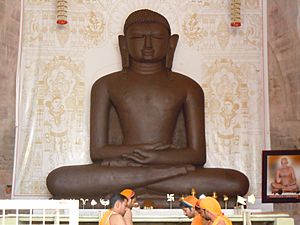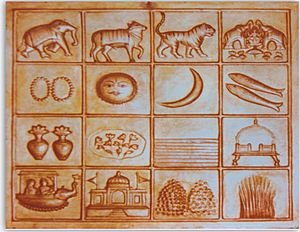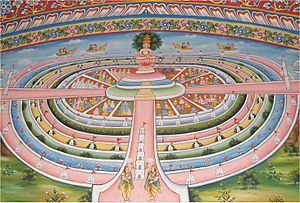Tirthankara facts for kids
In Jainism, a tirthankara is like a special teacher or guide. They are believed to know everything and show people the way to freedom from the cycle of birth and death, called saṃsāra. Jains believe that over time, their teachings can be forgotten. Then, a very rare person is born who decides to leave the normal world. They work hard to overcome the cycle of death and rebirth on their own.
Once a Tirthankara gains Kevala Jnana (which means they know absolutely everything), they help restart Jainism. They create a path for others to follow, leading from saṃsāra (living in the world) to moksha (complete freedom).
Jains believe that exactly twenty-four tirthankaras appear in each half of the Jain time cycle. The very first tirthankara was Rishabhanatha. He is said to have taught people many skills, like farming. The 24th and last tirthankara of our current time cycle was Mahavira (who lived from 599 to 527 BC). Before him, Parshvanatha was the twenty-third tirthankara, and he was a real historical person.
The teachings of a tirthankara are collected in holy books called Agamas. All tirthankaras teach the same ideas and rules for living. Their teachings always agree with each other. Jains worship tirthankaras, but it is believed their wisdom helps all living things, no matter their religion.
Tirthankaras are also called Jina, which means "victor." This is because they have won against inner enemies like anger, being too attached to things, pride, and greed. They are completely free from all strong feelings, and they don't have personal likes or dislikes. After they gain all knowledge, they are free from things like hunger, thirst, or needing to sleep.
Contents
Five Special Events
There are five very special events in the life of every tirthankara. These are called Pañca kalyāṇaka:
- Conception (Gārbha kalyāṇaka): This is when the soul of the tirthankara enters their mother's body.
- Birth (Janma kalyāṇaka): This is the birth of the tirthankara. Indra, who is the leader of heavenly beings, performs a special ceremony for the tirthankara on Mount Meru.
- Renunciation (Dīkṣā kalyāṇaka): This is when a tirthankara gives up all their worldly belongings and becomes an ascetic (someone who lives a very simple, strict life).
- Omniscience (Jñāna kalyāṇaka): This is the moment a tirthankara gains all knowledge and knows everything. After this, heavenly beings build a special preaching hall called a samavasarana. From here, the tirthankara gives sermons.
- Liberation (Nirvāṇa kalyāṇaka): When a tirthankara leaves their body, it is called nirvana. This is followed by their final freedom, moksha. Their soul then goes to Siddhashila, which is the highest part of the Universe in Jain belief. There, they live in happiness forever.
The Samavasarana
After a tirthankara knows everything, they teach others the way to freedom in a special place called a samavasarana. Jain texts say that heavenly beings build this amazing hall. In it, heavenly beings, humans, and animals all gather to listen to the tirthankara. Everyone, both humans and animals, can understand the tirthankara's speech in their own language. It is believed that during this speech, there is no sadness for miles around the area.
Tirthankaras and Time
Jainism teaches that time has no beginning or end. It moves like a wheel. Jains divide the time cycle into two halves: Utsarpiṇī (ascending time) and avasarpiṇī (descending time). Twenty-four tirthankaras are born in each half of this cycle. In Jain tradition, the tirthankaras were kings or queens in their last lives. Jain texts even tell stories about their past lives.
Twenty-one of the tirthankaras are said to have achieved moksha while standing still in meditation (this is called kayotsarga). Rishabhanatha, Neminatha, and Mahavira are said to have achieved moksha while sitting in the lotus position (called Padmasana).
List of the 24 Tirthankaras
Tirthankaras of Our Current Age
Here are the names, symbols, colors, and heights of the 24 tirthankaras of our current age, in order. Dhanuṣa means "bow" and hatha means "hands," which were old ways of measuring height.
| No. | Name | Symbol | Colour | Height |
|---|---|---|---|---|
| 1 | Rishabhanatha (Adinatha) | Bull | Golden | 500 dhanuṣa |
| 2 | Ajitanatha | Elephant | Golden | 450 dhanuṣa |
| 3 | Sambhavanatha | Horse | Golden | 400 dhanuṣa |
| 4 | Abhinandananatha | Monkey | Golden | 350 dhanuṣa |
| 5 | Sumatinatha | Goose | Golden | 300 dhanuṣa |
| 6 | Padmaprabha | Padma | Red | 250 dhanuṣa |
| 7 | Suparshvanatha | Swastika | Golden | 200 dhanuṣa |
| 8 | Chandraprabha | Crescent Moon | White | 150 dhanuṣa |
| 9 | Pushpadanta | Crocodile or Makara | White | 100 dhanuṣa |
| 10 | Shitalanatha | Shrivatsa | Golden | 90 dhanuṣa |
| 11 | Shreyanasanatha | Rhinoceros | Golden | 80 dhanuṣa |
| 12 | Vasupujya | Buffalo | Red | 70 dhanusa |
| 13 | Vimalanatha | Boar | Golden | 60 dhanusa |
| 14 | Anantanatha | Porcupine (Digambara) Falcon (Śvētāmbara) |
Golden | 50 dhanuṣa |
| 15 | Dharmanatha | Vajra | Golden | 45 dhanuṣa |
| 16 | Shantinatha | Antelope or deer | Golden | 40 dhanuṣa |
| 17 | Kunthunatha | Goat | Golden | 35 dhanuṣa |
| 18 | Aranatha | Nandyavarta or fish | Golden | 30 dhanuṣa |
| 19 | Māllīnātha | Kalasha | Blue | 25 dhanuṣa |
| 20 | Munisuvrata | Tortoise | Black | 20 dhanuṣa |
| 21 | Naminatha | Blue lotus | Golden | 15 dhanuṣa |
| 22 | Neminatha | Shankha | Black | 10 dhanuṣa |
| 23 | Parshvanatha | Snake | Blue | 9 hatha |
| 24 | Mahavira | Lion | Golden | 4 hatha |
Images for kids
-
Jain chaumukha sculpture at LACMA, 6th century
-
Famous idol of Mahavir Swami at Shri Mahavirji
See also
 In Spanish: Tirthankara para niños
In Spanish: Tirthankara para niños












